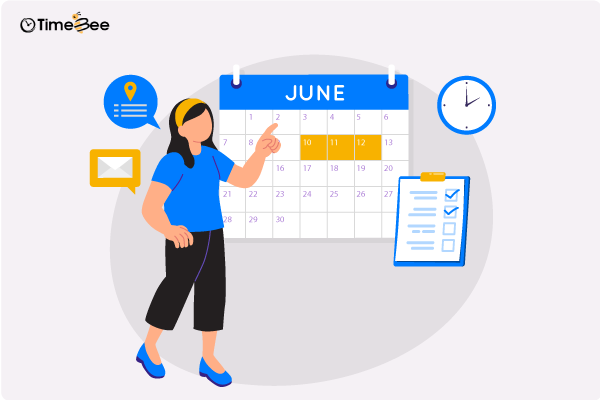Content
Content
Employee productivity is directly correlated to your company’s growth and profits. In 2023, unproductive teams and disengaged employees cost the global economy $8.8 trillion, equivalent to 9% of the world’s GDP.
This lack of productivity is hurting small businesses the most. Employers like yourself are finding it challenging to maintain productivity. While some of this can be attributed to the change to a remote-first culture, there are several other factors, such as ‘quiet quitting,’ that have contributed to the decline in productivity.
If you are an affected employer, consider conducting a productivity analysis and measuring your employees’ productivity to ensure efficient operations. Productivity analysis helps you identify inefficiencies, optimize resources, make strategic decisions, enhance competitiveness, and more.
In this blog, we will discuss the difference between productivity and its analyses, how to measure employee productivity, what tools are most common and easily accessible, the best implementation practices, and more.
What Is Employee Productivity Analysis?
Employee productivity analysis systematically evaluates and measures your employees’ efficiency and effectiveness in completing tasks, producing outputs, or achieving goals within a specific timeframe.
It involves collecting, analyzing, and interpreting quantitative and qualitative data such as output volume, quality, time spent on tasks, and resource utilization.
It aims to identify strengths, weaknesses, patterns, and areas for improvement in employee performance.
It is essential to distinguish productivity from productivity analyses. Although both may sound the same, they have different definitions.
Refer to the table below for the differences between productivity and productivity analyses.
Productivity vs Productivity Analyses
| Productivity | Productivity Analyses. |
| Looks at efficiency and resource utilization. | Measures overall efficiency and output compared to inputs. |
| Focuses on assessing performance and efficiency. | Refers to the general efficiency of an organization or project. |
| Analyzes how well time and resources are used. | Represents the output gained from the resources invested. |
| Involves examining specific tasks or processes. | Doesn’t focus on individual tasks but overall performance. |
| Evaluates efficiency through data and analysis. | Reflects the ratio of output to input without specific analysis. |
Productivity is a broader term, while productivity analyses involve a more detailed examination and assessment of productivity-related factors within an organization.
RELATED:
10 Reliable Ways to Improve Productivity at Work
How to Measure Productivity?
Measuring productivity involves assessing the efficiency of converting inputs into outputs. There are several ways to measure productivity across various industries and roles. Here are the top 10 approaches.
1. Output Per Hour/Day/Week
Output per hour/day/week involves tracking and evaluating the tasks or projects an employee completes in an hour, day/week to measure productivity.
Project management software or time-tracking tools can record and analyze the number of tasks assigned in these designated timeframes. However, to ensure positive results, you’ll have to:
- Set achievable objectives for work output within each timeframe.
- Ensure employees have clear instructions and understand tasks.
- Regularly track and assess the completion rates to identify patterns and productivity trends.
This approach allows for a deeper employee productivity analysis that facilitates better workload management to enhance overall efficiency.
Quality Of Work
Quality evaluation is crucial for assessing the standard of work delivered by employees. It involves establishing clear criteria that define high-quality work.
Here are some actionable steps to ensure a better quality of work and increased productivity.
- Define specific guidelines or metrics that outline what qualifies as high-quality work within your organization.
- Create a system that encourages regular feedback from managers, peers, or clients, providing constructive criticism to improve work quality.
- Provide opportunities for skill enhancement through workshops, training sessions, or educational resources to enhance the necessary skills.
These clear benchmarks motivate employees to deliver high-quality work consistently, ultimately enhancing overall productivity and output quality.
Meeting Deadlines
This reflects an employee’s ability to complete tasks within specified timelines. To ensure this, consider the following steps:
Use project management tools or task schedulers to establish deadlines.
Consistently monitor progress against set deadlines to measure compliance and identify potential delays.
Encourage effective time management strategies among employees to optimize their workflow and meet deadlines consistently.
Assist employees in understanding the importance and urgency of tasks, enabling them to prioritize effectively.
By emphasizing the importance of meeting deadlines and offering support or training in time management, employees can enhance their efficiency and can work more productively to achieve the targets.
Attendance & Punctuality
Attendance and punctuality are important indicators that reflect employees’ consistency and timeliness.
Therefore, you must record your team’s attendance and encourage punctuality. Here are a few ways you can do this.
Maintain attendance records through timesheets or attendance monitoring systems.
Foster a positive workplace culture that encourages employees to maintain regular attendance voluntarily.
Offer rewards, recognition, or incentives for consistent attendance to reinforce punctuality and commitment.
Identify and address any factors or challenges hindering employees’ consistent attendance. Provide necessary support or accommodations if required.
Implement these steps to create a more disciplined and engaged workforce.
Sales Or Revenue Generated
Measuring sales or revenue-generated progress involves evaluating an employee’s impact on the company’s sales figures or revenue streams. To assess this:
- Use sales tracking software or financial reports to monitor individual contributions to sales or revenue generation.
- Set achievable sales targets or revenue goals for each employee. This helps in quantifying individual performance.
- Provide specialized sales training sessions to enhance employees’ selling skills, product knowledge, negotiation tactics, or customer interaction techniques.
Measuring your employees’ productivity based on sales or revenue generation can help businesses understand individual sales performance, identify areas for improvement, and provide targeted support to enhance sales effectiveness.
Efficiency In Completing Tasks
This aspect focuses on an employee’s ability to finish assigned tasks promptly while maintaining quality. To measure this:
- Use time-tracking or productivity software to monitor the duration taken for task completion. Analyze the time spent against the task’s complexity to gauge efficiency.
- Encourage employees to refine their work processes by identifying bottlenecks or time-consuming steps.
- Streamline workflows or adopt new tools that aid in quicker task execution.
- Provide guidance or training on effective task management techniques, prioritization, or time management skills.
Efficient task completion ensures timely project deliveries, boosts overall productivity, and allows employees to handle their workload more effectively, contributing to the organization’s success.
Customer Satisfaction Ratings
Customer satisfaction ratings measure how much an employee’s work positively impacts a customer’s happiness and contentment. Here are a few ways to evaluate customer satisfaction ratings.
Gather feedback through various channels, such as surveys, reviews, or direct customer interactions. Analyze this feedback to understand customer sentiments.
Encourage employees to engage with customers actively and understand their needs to provide exceptional service.
Act on negative feedback constructively. Identify areas for improvement and provide necessary support or training to enhance service quality.
Customer satisfaction ratings give you an excellent benchmark against which to tally your employees’ performance, especially if they are in a customer-facing role.
Project Completion Rates
Measuring the successful fulfillment of assigned projects or tasks given to an employee within predetermined timelines can help optimize productive output. To effectively utilize this measure:
- Maintain a detailed record of completed projects aligned with the initially set deadlines or schedules.
- Employ robust project management methodologies to monitor and manage project progress, ensuring alignment with the planned schedules.
- Ensure optimal allocation of resources, including human capital, finances, and time, to support and expedite project completion.
Conducting regular reviews to identify inefficiencies in the project workflow will help you make necessary adjustments to enhance project completion rates and overall efficiency.
Utilization Of Resources
If you are providing your team with the needful resources but are still seeing the gap in workflow, implement the following:
- Regularly evaluate the allocation of resources against the achieved outcomes to ensure optimal utilization.
- Provide training sessions focusing on efficient resource management techniques, enhancing employees’ ability to maximize resource utility.
- Foster a collaborative work culture where employees share resources, ideas, and tools, allowing for collective optimization and efficient resource utilization.
Provide access to updated tools, technologies, and necessary resources and empower your employees to enhance productivity through effective resource utilization.
Improvement In KPIs
Improvement in Key Performance Indicators (KPIs) represents an employee’s enhancement to critical business metrics, such as sales targets, customer retention, or service excellence. To effectively monitor and foster these improvements:
- Routinely analyze KPI data to identify trends, progress, and improvement areas, enabling informed decision-making.
- Set achievable and relevant KPI targets aligned with business objectives that provide employees with clear milestones.
- Offer ongoing training, coaching, or mentorship programs to equip employees with the necessary skills and knowledge to positively impact KPIs.
Create a feedback culture where insights from KPI analyses are shared to foster transparency and encourage employees to contribute to KPI enhancements.
3 Tools and Technologies for Measuring Productivity
In this technologically converged era, businesses need tools to provide actionable insights, enhance collaboration, and optimize processes to achieve higher levels of productivity and efficiency.
Project Management Tools
Project management tools like Asana, Trello, or Jira are software solutions that aid in planning, organizing, and managing tasks and projects.
These tools allow teams to allocate tasks, set deadlines, track progress, and collaborate efficiently. They provide insights into employee productivity by monitoring task completion rates and timelines.
In today’s dynamic work environment, where teams are often distributed, project management tools centralize workflows, streamline communication, and offer transparency, optimizing productivity.
Employee Monitoring Software
Employee monitoring software like TimeBee tracks and analyzes employee activities, including time spent on tasks, visited websites and apps, etc.
TimeBee is not just a simple monitoring tool; it also helps manage projects, budgets, and the workforce. It helps businesses gain better insight into employee work patterns, quarterly and overall performance, productivity levels, and more.
Some key features include
A time tracker that clocks employees’ time and records the data in digital timesheets to allow businesses to track and analyze employees’ activities. It enhances productivity, facilitates accurate payroll processing, and provides insights for resource optimization and compliance.
The screenshot feature captures employees’ screens and provides visual insights into employee work progress and activity levels. This enables managers to evaluate the team’s performance and identify areas for improvement, especially for the remote teams.
Web and App activity reports provide detailed insights into an employee’s web and app usage during work hours. It collects the data and categorizes the apps and sites as productive, unproductive, neutral, or unrated, depending on the company settings for each category according to the organization’s needs.
The distraction alert pop-up keeps the employees focused on their work. Whenever the screen is idle or they’re on break for too long, the app will pop up a notification asking the user to return to work.
Productivity analysis reports provide a detailed insight into employees’ progress and workflow blockages to help managers make informed decisions. It gathers this data by monitoring the whole workday and clocking hours with timestamps.
These features empower businesses to efficiently track employee activities, optimize workflows, maintain transparency, and make data-driven decisions for improved productivity and performance.
With remote work becoming more prevalent, such tools help managers gauge productivity, address inefficiencies, and ensure optimal utilization of work hours.
Analytics & Data-Driven Platforms
Analytics tools like Microsoft Power BI, Google Analytics, or Tableau leverage data to generate insights, trends, and performance metrics.
These platforms collect data from various sources and offer comprehensive analytics on employee performance, workflow efficiency, and resource allocation. They aid in making data-driven decisions to enhance productivity.
In an increasingly competitive landscape, these analytics and data-driven platforms provide accurate data analysis to understand productivity drivers, identify areas for improvement, and ensure sustained growth.
Best Practices for Effective Employee Productivity Analysis
If you want to measure, improve, and sustain productivity levels across your company, the following best practices will foster employee engagement, satisfaction, and high performance.
Establish Clear & Measurable Goals
Setting precise and achievable objectives aligned with organizational goals is essential, as it will give you a clearer view of your team’s progress.
SMART goals (Specific, Measurable, Attainable, Relevant, and Time-bound) are the best way to establish clear and measurable goals. Implement it by communicating with your team and ensuring they understand the objectives clearly.
Committing to these objectives will allow accurate progress and performance measurement against predefined benchmarks. It will enable you to identify problems that need immediate attention and recognize what works for the company to accomplish targets.
Provide Adequate Resources & Support
To create a more dynamic and productive workforce, you must provide your team with all the necessary tools, training, and support to perform their roles effectively. Ensure employees have access to required resources, technology, and training. Facilitate a supportive work environment where employees feel empowered and encouraged to ask for help.
Using the right tools reduces obstacles that hinder productivity and enhances employee morale. It also enhances employee engagement and efficiency, which leads to improved performance outcomes.
Regular Performance Evaluations & Feedback Loops
For optimized workflow, all businesses must consistently assess employee performance and foster open communication for continuous improvement.
Conduct periodic performance evaluations aligned with specific metrics or KPIs. Provide constructive feedback, acknowledging achievements, and addressing areas for improvement.
Modern businesses need this more than ever to facilitate discussions on strengths, weaknesses, and areas needing development to enhance productivity. It’ll streamline all your business processes without costing you a fortune.
Encourage A Healthy Work-Life Balance
A healthy work-life balance is one of the most critical aspects of productivity.
It promotes balancing work responsibilities and personal well-being. To help your workforce create a better balance, encourage flexible work hours, promote breaks, and discourage overtime. Provide resources or programs supporting mental health and work-life balance.
When the scale is balanced, it will reduce burnout, stress, and absenteeism. Your team will be more engaged, focused, and productive.
Utilize Continuous Improvement Strategies
As a manager, you are responsible for adopting a culture of ongoing enhancement and innovation. Aim to create a positive work culture where employees feel safe, empowered, and motivated to accomplish their goals and targets.
Fostering a productive work culture will not require huge adjustments. Little things will make a big difference. For example, encourage your team to propose ideas for process improvements and make them feel included.
When your team is happy and contented, it will enable your organization to evolve, innovate, and adapt to changing dynamics while facilitating sustained productivity growth.
Conclusion
Understanding and enhancing employee productivity is paramount for success in today’s competitive business landscape. Employee productivity analysis isn’t just about quantifying work output; it’s a comprehensive process that involves assessing, optimizing, and leveraging resources and capabilities to drive organizational growth.
Implementing effective productivity measurement techniques empowers businesses to identify inefficiencies, optimize resources, and enhance competitiveness while nurturing a healthy work-life balance.
Embrace small, incremental changes like implementing TimeBee, which provides comprehensive features, including output tracking, quality assessment, deadline adherence, attendance monitoring, and customer satisfaction evaluation,
It offers actionable insights for efficient workforce management. With its suite of tools and analytics, TimeBee simplifies the process of assessing productivity, fostering a culture of improvement, and ensuring optimal resource utilization, thus paving the way for sustainable organizational success.
Similar Reading



